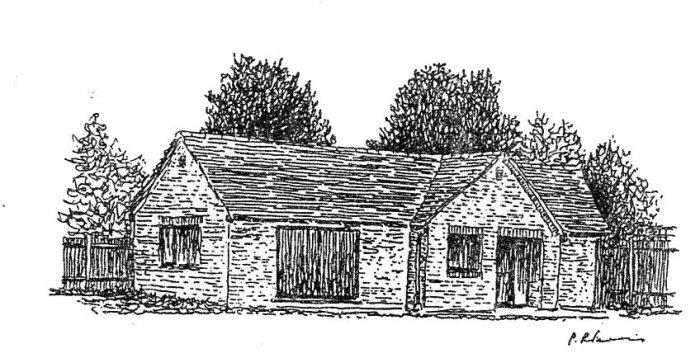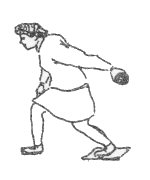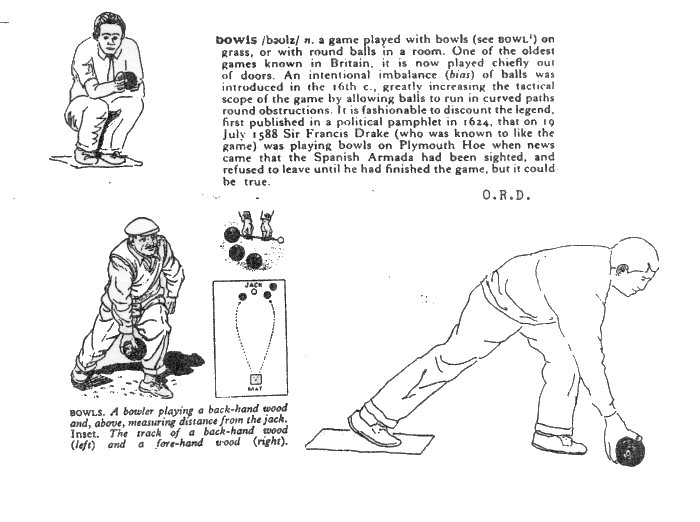No.88 A HISTORY OF THE ALRESFORD BOWLING CLUB
by Lesley Drew
Alresford's Bowling Club is reputed to be the second oldest Bowling Club in Hampshire. Sadly this cannot be proved, as for some reason there was a break in its activities between the two world wars, and the records only date from the time of the Club's reformation at the end of 1937.
It is said that bowls were being played in Alresford at the time of the Civil War in 16M2. The Hampshire Records Office lists Titchfield as the county's oldest Bowling Club, with the date 1620, but the word "club" must be used cautiously, as Royal Statutes between 1388 and 1750 for some reason forbade the existence of organisations for sports or pastimes. More probably Titchfield is the oldest Green in the County, in which case Alresford can quickly lay claim to its second position.
Alresford's historian, the late Dr Isabel Sanderson, discovered the existence of a bowling green in the town in the 17th century. An entry in the Minute Book of the Bailiff and Burgesses of New Alresford in 1651 refers to a broken fence belonging to William Langley, between his lands called Marditch, and the lands of John Venables, called The Bowling Close. Marditch was one of the Common Fields on the east side of Sun Lane. It would appear then, that the 17th century Bowling Close was on the opposite side of the road from the present Bowling Green in Sun Lane.
A Bowling Close footway is shown on the 1807 Enclosure Map of New Alresford. This runs from the parish churchyard, crosses Sun Lane and continues eastward to Bishop's Sutton. Presumably the footpath was itself a boundary to the original bowling green. It is almost certain that when the large Langston House was built in the 18th century, a new Green was created on the other side of the road, on land belonging to The Sun Inn.
Evidence of the present Green is found in a copy of The Hampshire Chronicle dated August 1823, which says "The Gentlemen of the Bowling Green held their annual festival at The Sun Inn, Alresford, which was most numerously and respectably attended".
Crowley & Co. Ltd., Brewers of Alton, took over The Sun Inn in 1902, but any records they may have had in their possession concerning the Bowling Club, have, like the Brewery itself, disappeared.
A photograph taken in 1910 shows James Sait, then aged 78 years on the Green with fellow players. He was a well-known figure in the town, with his home and boot making business in Broad Street. He, was church sexton for 50 years, and served as parish clerk for 44 years.

No one knows what led to the bowling green being abandoned to nature, but it was a Londoner who was to restore the games of bowls to Alresford. Sidney Lane first lived in Alresford during the First World War when his boss, solicitor George Ridley Shield, moved his business to the town for the duration. After the war was over, it was with reluctance that Sidney returned to London, When he retired almost twenty years later, in 1937, he and his wife came to live in East Street.

Dismayed to discover the bowling green unused and neglected, Sidney Lane promptly set about reforming the club. A meeting was held at The Sun Inn on 23 November 1937 and the club was formed with such personalities as Canon A.J. Robertson, who was to be the first chairman, Lord Templemore, Sir Anthony Tichborne, Sir Francis Lindley, Doctors Leishman and Meryon, and Mr. George Ridley Shield, son of J. Ridley Shield, who was elected President, with Sidney Lane as Secretary. Mr. Cameron Black, the publican, agreed the club could rent the rink for £10 per annum, and the membership fee was set at five shillings a year, plus a payment of twopence a game.
Meetings took place monthly, but although it is known that the Green needed much renovation, no reference appears in the minutes, as to the work undertaken. In January 1938, members were sufficiently appreciative of the generosity and support given by Mr. Pemberton, in supplying and distributing manure for the Green, that he was invited to be Vice President! By May it was noted Mr. Davey had completed work on the Green and was to be appointed greenkeeper for ten shillings a week. Mr. H. Blake was Games Captain, and Mr. F. Bascombe, Vice Captain.
At the end of 1938 it was agreed membership be opened to ladies with a reduced fee of two shillings and sixpence. It appears they were not enthusiastic, as the accounts of the following year show the club had thirty members at five shillings a head.
Minutes of meetings were recorded meticulously in the ensuing years, but offered few details of activities. Nothing indicated that the world was at war again. Finance was the main pre occupation of the committee, and in December 1940 matters were serious. The club had only paid £5 of its £10 rent to The Sun Inn. A special meeting was called, at which the landlord was present. When the matter was put before him, he agreed to make a donation of £2. 10s. Od towards the rent. This was received with much relief. The club paid the remaining £2. 10s. Od, which left Is. 4d in the bank.
During the war years matches were played with Five Ash Bowling Club near Four Marks and with the Winchester Consrvative Club. When The Swan Hotel in Alresford set about raising funds for a Victory Gardens week in August 1943, - the Bowling Club members were invited to stage an open tournament. With Canon Robertson no longer in the chair, in 1945 the club agreed to make Sunday play optional for members.
In 1946 the club's king pin was still Sidney Lane, more affectionately known as "Lofty" Lane, as at six foot two inches, he stood head and shoulders over most men. Lofty's enthusiasm was boundless, and neither was he shy in coming forward. When he noticed Sir Francis Lindley had not sent the club a donation as usual, he wrote to the beg Right Honourable's pardon, and respect fully pointed out the omission. Lofty's letter of thanks to the John Bull Rubber Company of Leicester, for their donation of four rubber mats in 1949 was charming enough to warrant a reply from them. The company wished that more could be done to help the club, but explained that profits were vastly reduced "since this present government started so grossly to mismanage our national affairs".
In 1952 it was rumoured the brewers were planning to close The Sun Inn. Mr. Ridley Shield, still President after 14 years, wrote to Crowleys Brewery, expressing the club's concern over the Green. He asked Crowleys to ensure the Green would pass to other hands when the Inn became redundant. It was, he said, a Green of considerable antiquity, being to his knowledge, at least 150 years old, and the second oldest in the county. The brewers replied they had no immediate plans for The Sun Inn, and so members were able to relax and enjoy Coronation Year 1953- On Coronation Day, the club had a special open bowls competition.
The Inn closed on 27 August 1957, but whilst the building was sold as a private home to Hampshire's cricket commentator, John Arlott, the laud was divided, and the Bowling Green sold to Lt. Col. Chapman, whose home, Langton Lodge backed on to The Green on the south side. Col. Chapman purchased the land with the proviso that it be kept as a bowling green for at least 5 years.
The austerity years of the fifties had a dismal effect on the club. Membership slumped to just 1M. However, Col. Chapman was a keen supporter, and joined the committee. He later served as President for many years. He built a new entrance from Sun Lane to the ground, undertook clearance and cutting of hedges , and granted permission for the building of a small wooden pavilion clubhouse. He also altered the clause in the sale of the land to read that the club could have the use of The Green for as long as he or one of his family lived at Langton Lodge.
During the sixties, membership grew, and Col. Chapman expressed great pleasure at being able to hear from his home, the clunk of woods on a summer evening. More matches were being played with other clubs, and annual competitions took place. One was the Langton Cup presented by Col. Chapman, which is still played for today between Alresford and its nearest bowling neighbour, Ropley. Lofty Lane presented a silver bowl and a medal for club competitions in 1958, the year he was no longer secretary, but Vice President and Vice Games Captain.
Col. Chapman retired as President in 1967 and at the annual general meeting in November 1968, members stood in two minutes silence for their late Vice President, Sidney "Lofty" Lane. He had seen the club through thirty years of play.
Many excellent Secretaries, Chairmen and Presidents followed on through the years. By the mid seventies lady members were making their mark. Though even today vastly outnumbered by the men, they have produced some excellent players and more than one lady has held the office of Captain, When member Kate Kent moved from Alresford, she left behind a trophy for an annual ladies competition.
The death of Lt. Col Chapman in 1982 made the club's future uncertain once more. But he had left provision that the club could purchase the freehold of the land from his family at a nominal sum. Though beyond the resources of the club, members raised the cash, the freehold was purchased and trustees appointed.
Five years later, the committee was faced with another big decision. The small wooden club house, though lovingly maintained, was reaching the end of its life. It had no electricity, water came from a stopcock, and the adjoining hut with Ladies and Gents toilets were antiquated to the extent that they generally proved a talking point over tea with visiting clubs!
At this time Harry "Stan" Baldwin was Chairman, and Bert Tierney was halfway through his 10 year term of office as Secretary.
Bert was keen to see a new clubhouse built to ensure the future for succeeding generations. The building cost however was wholly beyond the means of the club. At this point, a developer, wishing to build bungalows next door, needed the small strip of land in front of the club's boundary hedge, for the purpose of a sight line. He offered the club a few hundred pounds to purchase.
Fortunately among the membership at this time was a chartered surveyor, Derek Drew. Bert Tierney asked for his advice, and Derek offered to take over the transaction. The original offer changed from hundreds to thousands, plus the supply of water, electricity, sewerage and a brick boundary wall. It still meant the club required several more thousand pounds for a permanent brick clubhouse. Derek Drew, working with Bert Tierney and with the support of the Chairman and committee, spent the next two years applying for Grants and acquiring donations. Again there was good fortune within the membership in the form of Bill Weller, a builder. His firm constructed the building and on 6 June 1990 the present attractive clubhouse was officially opened by Alex Hankin, a well known Alresfordian.
 Today the club has four rinks, a membership
of 70, and a waiting list of people wishing
to join. In 1991 they played 41 fixtures.
Today the club has four rinks, a membership
of 70, and a waiting list of people wishing
to join. In 1991 they played 41 fixtures.
Television has increased the popularity of the game which now extends to all age groups and is no longer laughingly called "old men's marbles". But the game itself has maintained the early disciplines. Unlike other sports, excessive emotions are never displayed. Language remains calm. Players shake hands ... and go into tea.
(C) Lesley Drew October 1994.
